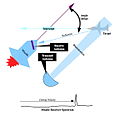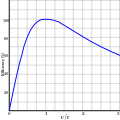Portal:Rocketry
The Rocketry Portal

A rocket (from Italian: rocchetto, lit. 'bobbin/spool') is a vehicle that uses jet propulsion to accelerate without using any surrounding air. A rocket engine produces thrust by reaction to exhaust expelled at high speed. Rocket engines work entirely from propellant carried within the vehicle; therefore a rocket can fly in the vacuum of space. Rockets work more efficiently in a vacuum and incur a loss of thrust due to the opposing pressure of the atmosphere.
Multistage rockets are capable of attaining escape velocity from Earth and therefore can achieve unlimited maximum altitude. Compared with airbreathing engines, rockets are lightweight and powerful and capable of generating large accelerations. To control their flight, rockets rely on momentum, airfoils, auxiliary reaction engines, gimballed thrust, momentum wheels, deflection of the exhaust stream, propellant flow, spin, or gravity.
Rockets for military and recreational uses date back to at least 13th-century China. Significant scientific, interplanetary and industrial use did not occur until the 20th century, when rocketry was the enabling technology for the Space Age, including setting foot on the Moon. Rockets are now used for fireworks, missiles and other weaponry, ejection seats, launch vehicles for artificial satellites, human spaceflight, and space exploration.
Chemical rockets are the most common type of high power rocket, typically creating a high speed exhaust by the combustion of fuel with an oxidizer. The stored propellant can be a simple pressurized gas or a single liquid fuel that disassociates in the presence of a catalyst (monopropellant), two liquids that spontaneously react on contact (hypergolic propellants), two liquids that must be ignited to react (like kerosene (RP1) and liquid oxygen, used in most liquid-propellant rockets), a solid combination of fuel with oxidizer (solid fuel), or solid fuel with liquid or gaseous oxidizer (hybrid propellant system). Chemical rockets store a large amount of energy in an easily released form, and can be very dangerous. However, careful design, testing, construction and use minimizes risks. (Full article...)
Selected article -
The Nuclear Engine for Rocket Vehicle Application (NERVA; /ˈnɜːrvə/) was a nuclear thermal rocket engine development program that ran for roughly two decades. Its principal objective was to "establish a technology base for nuclear rocket engine systems to be utilized in the design and development of propulsion systems for space mission application". It was a joint effort of the Atomic Energy Commission (AEC) and the National Aeronautics and Space Administration (NASA), and was managed by the Space Nuclear Propulsion Office (SNPO) until the program ended in January 1973. SNPO was led by NASA's Harold Finger and AEC's Milton Klein.
NERVA had its origins in Project Rover, an AEC research project at the Los Alamos Scientific Laboratory (LASL) with the initial aim of providing a nuclear-powered upper stage for the United States Air Force intercontinental ballistic missiles. Nuclear thermal rocket engines promised to be more efficient than chemical ones. After the formation of NASA in 1958, Project Rover was continued as a civilian project and was reoriented to producing a nuclear powered upper stage for NASA's Saturn V Moon rocket. Reactors were tested at very low power before being shipped to Jackass Flats in the Nevada Test Site. While LASL concentrated on reactor development, NASA built and tested complete rocket engines. (Full article...)In the news
- 22 May 2024 –
- Russia launches a Soyuz-2 rocket carrying the Kosmos 2576 satellite from the Plesetsk Cosmodrome launch site in Arkhangelsk Oblast. The United States Space Command accuses it of being an anti-satellite weapon capable of attacking other satellites, and is in the same orbit as a satellite operated by the National Reconnaissance Office. (Al Jazeera)
- 19 May 2024 – Russian invasion of Ukraine
- At least six people are killed and 27 others are injured in a Russian double tap missile strike on a recreation area near Kharkiv. Separately, five people are killed and nine others are injured in a Russian strike using a multiple launch rocket system on two villages in Kupiansk Raion, Kharkiv Oblast. (Reuters)
Topics
List articles
Things to do
 |
Here are some tasks awaiting attention:
|
Wikimedia
The following Wikimedia Foundation sister projects provide more on this subject:
-
Commons
Free media repository -
Wikibooks
Free textbooks and manuals -
Wikidata
Free knowledge base -
Wikinews
Free-content news -
Wikiquote
Collection of quotations -
Wikisource
Free-content library -
Wikispecies
Directory of species -
Wikiversity
Free learning tools -
Wikivoyage
Free travel guide -
Wiktionary
Dictionary and thesaurus




















































